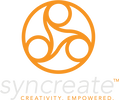At Syncreate, we’re interested in what the brain has to teach us about how to grow connections, transform communities, and foster adaptability. So far our investigations have lead us into discussions and presentations about the neuroscience of creativity, and the ways in which educators and leaders can strategically build creative communities. As community college professors, we are currently exploring the ways neural pathways grow, strengthen, and become pruned.
We constantly keep these questions in mind:
• Can educators take inspiration from neural networks to create relational links that weave students and content more tightly together?
• If we encourage students to see themselves and their peers as resources, could we create a buzz within learning communities that encourages new and meaningful connections between people, ideas, and real-world challenges?
• How can play, ritual, and community-building exercises create new neural pathways through kinesthetic, embodied learning?
We don’t necessarily have all these answers to these questions, but we believe asking the questions may reveal the path to becoming more effective, engaged, and collaborative in our educational work.
New insights into neural architecture, (also known at the connectome) such as the work of Dr. Van J. Wedeen of the Martinos Center for Biomedical Imaging at Massachusetts General Hospital, reveal the deeply interwoven quality of the brain’s structure (see “New Discoveries in Brain Structure and Connectivity”). In addition, current neuroscience research offers exciting insights, such as the brain’s incredible ability to artfully enhance helpful connections or prune away unused pathways. Every synapse creates a connection and the more times a neuron fires, the stronger a synaptic connection becomes. In other words, the brain changes with every new experience and nothing exists in isolation. We’d like to suggest that with every experience in the classroom (and within the institution itself), the student’s brain, thinking process, and understanding of the world changes. Educators who embrace this idea become empowered to skillfully plan classroom lessons, discussions, and activities to facilitate more powerful and lasting connections.
Each student is part of the classroom “brain,” if you will. It’s not that teachers stand in the front of the classroom and transmit ideas; instead, teachers can facilitate connections and pathways between students. However, in order for this to work well, we first have to acknowledge the creativity, unique perspectives, and resiliency of each student present. If we don’t, we might unwittingly “prune” the student from the necessary pathways he/she needs to connect, comprehend, and succeed. For example, the website Mindfulness Starts Here states, “Neural pruning is the process of removing neurons that are no longer used or useful in the brain.” For those students who don’t have a positive family history or positive personal experiences with school and/or higher education, the figurative neural connection to the classroom may be shallow or tenuous, and therefore it only takes a few experiences of isolation to “prune” the student from engaging in the classroom.
Educators interested in enhancing connection can welcome a sense of play and associative thinking by conceptualizing the classroom as a type of extra-neural network that fosters meaningful connection, encourages empathy, honors student well-being, implements strategic collaboration, and emphasizes creative problem solving. At the heart of the neural classroom is a faith in creativity to forge new pathways and to connect students in meaningful ways so that each person is woven into the fabric of the learning environment. Many teachers already do this by encouraging students to work together outside of the classroom on collaborative projects. Learning to work with others isn’t just a social skill; it’s essential in both drawing out the strengths of each student and interlacing individuals to ensure the resiliency of the entire classroom.
We suggest that promoting creative/associative thinking can teach students how to value their own ideas and learn to enjoy the process of thinking. How to Think Like Leonardo da Vinci author Michael Gelb offers many creativity-enhancing activities, including an exercise of comparing two seemingly unrelated items or concepts. Taking this into the classroom, teachers can ask students to consider what two disparate ideas have in common and write all of their answers on the board. Students thus learn to take risks (for example, a bird is like a typewriter because they both can involve pecking; the array of typebars is similar to a bird’s rib cage) and create connections to other students who resonate with their analogies. If educators can prioritize a portion of teaching time to making creativity a daily exploration, students learn courage, adaptability, and collaboration. Indeed, Linda Smarzik, author of The Mind of Thuse!! Thriving With Effortlessness, observes, “Taking small risks, and doing so consistently, shifts us out of our comfort zones into the process of creativity.”
Additionally, the instructor who emphasizes collaboration, active listening, and dialogue might, in fact, be using neural mimicry to weave together a classroom that breeds student success. Creativity can enhance neuroplasticity (the dynamic process of brain rewiring), which can serve as a classroom strategy for reaching all students and weaving them into the fabric of engagement and success.
If you find this concept worthy of further exploration, please vote for our proposed “The Classroom as a Neural Network” topic at the 2014 SXSW Education Conference (SXSWedu) PanelPicker forum. It will take about two minutes of your time. Voting opens Monday, August 19 and closes Friday, September 6, 2013. Thank you for your support!

 RSS Feed
RSS Feed
